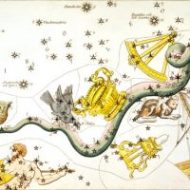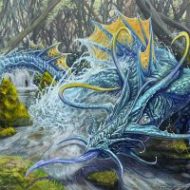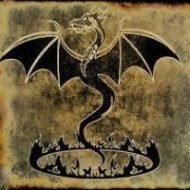Bashmu : The Horned Serpent
Listen
At a glance
| Description | |
|---|---|
| Origin | Babylonian Mythology |
| Classification | Hybrids |
| Family Members | N/A |
| Region | Iraq |
| Associated With | Astronomy |
Bashmu
Introduction
The Bashmu, also known as the “Venomous Snake,” is a fearsome creature from Mesopotamian mythology. It is often described as a massive horned serpent with wings and forelegs, blending the traits of snakes, dragons, and other monstrous beings. The Akkadians associated it with a constellation resembling the Greek Hydra, symbolizing its immense power and cosmic presence.
References to Bashmu appear in early Sumerian and Akkadian texts, where it was one of the primeval forces of chaos. It often appeared as an agent of destruction in myths, linked to deities like Nergal, Palil, and most prominently Tiamat, the primordial goddess of chaos. Though not as well-known today as other Mesopotamian beasts such as the Mushussu, the Bashmu carried deep symbolic meaning in ancient Mesopotamia as an embodiment of danger, chaos, and untamed natural power.
Physical Traits
The Bashmu was no ordinary serpent—it was an enormous creature that combined aquatic and terrestrial traits. It was said to measure around sixty feet in length, with rows of razor-sharp teeth and occasionally multiple tongues, giving it an especially terrifying appearance. Some depictions describe it as having wing-like appendages attached to its forelegs, suggesting both amphibious and dragon-like qualities. Its horned head marked it as a supernatural being rather than a mere animal, tying it to divine or cosmic forces.
Though capable of swimming swiftly through rivers such as the Euphrates and Tigris, Bashmu was equally dangerous on land, where it preyed on livestock and humans. Its body was thought to be covered in thick scales that made it nearly invulnerable to weapons. Certain myths also attribute venomous fangs or a poisonous breath to it, elevating it from a monstrous predator to a near-apocalyptic threat. Its physical image strongly influenced later mythological serpents and dragons across the Near East and Mediterranean world.
Family
In Mesopotamian mythology, Bashmu was not a solitary beast but part of a larger mythological framework of chaos-monsters. It was one of the eleven monstrous offspring of Tiamat, the great sea-dragon of the Enuma Elish creation epic. Alongside other beings such as the Mushussu and Lahmu, Bashmu represented the destructive forces that opposed the younger gods.
In other accounts, the creature was unleashed by gods such as Nergal, the god of the underworld, or Palil, a pastoral deity, as a scourge upon humanity. In the Sumerian poem Angim (“Ninurta’s Exploits”), Bashmu was listed among the warriors defeated by Ninurta, the heroic god of war and agriculture. Its role in these myths underscores its importance as a cosmic adversary—too powerful for mortals to resist and requiring divine might to be subdued.
Other Names
Bashmu was known by several names in Mesopotamian texts, reflecting the long span of its mythological presence. It was sometimes referred to as Bashumu or Mussatur, both variations pointing to its identity as a monstrous serpent. The Sumerian term usum—meaning “serpent with feet”—is also associated with it, distinguishing it from ordinary snakes. In some contexts, it was called mus-sa-tur, which translates as “birth goddess snake,” possibly linking it to themes of fertility, death, and rebirth through its chaotic yet creative powers.
Powers and Abilities
The Bashmu was considered an apex predator of both land and sea, feared for its size, strength, and supernatural abilities. Measuring sixty feet long and capable of swallowing humans, animals, and even flocks whole, it was depicted as unstoppable without divine intervention. Its venom or toxic breath further amplified its threat, and some myths suggest that it could breathe fire—traits that align it with later dragon traditions.
As a servant of Tiamat, Bashmu embodied primordial chaos and destructive natural forces. It was considered nearly invincible, protected by scales that deflected weapons. Only gods like Ninurta or Nergal could slay it, highlighting the contrast between divine order and chaotic monstrosities. In this sense, Bashmu was not just a beast but also a symbol of the eternal battle between chaos and order that defined Mesopotamian cosmology.
Modern Day Influence
Unlike other mythological figures such as Gilgamesh or Ishtar, Bashmu’s story has largely faded from popular culture. Many Babylonian and Assyrian myths were lost or fragmented, and creatures like Bashmu were either forgotten or merged into later cultural symbols. However, its imagery survives indirectly.
Bashmu’s traits—venom, immense size, hybrid serpent-dragon body, and association with chaos—echo in later mythological creatures such as the Biblical Leviathan, the Greek Hydra, and even medieval European dragons. Its role as one of Tiamat’s monstrous brood also links it to the enduring archetype of chaos-serpents found across mythologies worldwide. In modern times, Bashmu occasionally appears in academic studies of Mesopotamian religion, role-playing games, and fantasy literature as a model for serpentine chaos-beasts.
Related Images
Sources
Black, J. A., & Green, A. (1992). Gods, Demons and Symbols of Ancient Mesopotamia: An Illustrated Dictionary. University of Texas Press.
Dalley, S. (2008). Myths from Mesopotamia: Creation, the Flood, Gilgamesh, and Others. Oxford University Press.
Leick, G. (1991). A Dictionary of Ancient Near Eastern Mythology. Routledge.
Ancient Origins. (2020, September 13). Bashmu: The primordial horned serpent-dragon of Mesopotamia. Retrieved from https://www.ancient-origins.net/myths-legends/bashmu-0013989
World History Encyclopedia. (2011, April 28). Enuma Elish: The Babylonian Creation Myth. Retrieved from https://www.worldhistory.org/Enuma_Elish
Frequently Asked Questions
Who is the Bashmu?
The Mesopotamian mythological creature known as the Bashmu or “Venomous Snake” was a horned snake with wings and forelegs.
Where did the Bashmu live?
The Babylonian hybrid creature Bashmu is said to have lived in the rivers Tigris and Euphrates.
Where is Babylon today?
Babylon which is where the mythology of the Bashmu is said to originate is located in modern day Iraq.
In which video game does Bashmu appear?
Bashmu is a playable character in the MMORPG Tibia which is popular even today despitye being over 25 years old.
Watch







